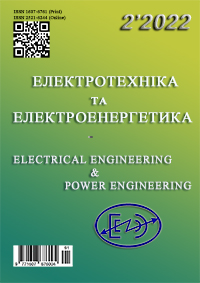Starting and stopping as energokinematic regimes of electric drives of indus-trial mechanisms
DOI:
https://doi.org/10.15588/1607-6761-2022-2-1Keywords:
technical terms, energy kinematic modes, movement, lockingAbstract
Purpose. To analyze the current technical terms that correspond to the physical processes in the electric drive system during atypical dynamic modes. Review possible modes in the kinematic parts of the electric drive during dynamic modes that may affect the nature of the transients. To form a definition of technical terms that characterize the real energy-kinematic regimes when moving and starting the electric drive of industrial mechanisms, which were not previously considered as insignificant or as non-existent.
Methodology. In order to solve the set tasks, the analysis of the technical terms defined by the technical literature, GOST, DSTU, etc. was carried out. To formulate new terminology for physical processes of atypical modes, the analysis of physical and energy processes occurring in the electrical and kinematic parts of the electric drive under such dynamic modes is performed..
Findings. Possible cases of atypical modes of operation of kinematic circuits and energy channels of energy conversion during the start-up of electric drives of technological mechanisms under load, for the characteristics of which there is no technical terminology, are identified. Based on the results of the analysis of energy-kinematic regimes, technical terminology is proposed, which fully covers and characterizes the considered atypical processes that take place during the moving and start-up of technological mechanisms.
Originality. For the first time, technical terminology has been proposed that characterizes the energy-kinematic modes of electric drives of technological mechanisms during start-up.
Practical value. For the first time, the use of technical terms is proposed for a clear and visual representation of energy kinematic modes that occur during the moving and start-up under load of different types of technological mechanisms.
References
Contributors to Wikimedia projects. Wikipedia is a free encyclopedia. Wikipedia is a free encyclopedia. URL: https://ru.wikipedia.org/wiki (access date: 15.04.2022).
Ozhegov's Explanatory Dictionary URL: https://slovarozhegova.ru/about.php (access date: 17.04.2022).
Large explanatory dictionary of the modern Ukrainian language / Uklad. and main. ed. W. T. Busel. K: Ir-pin: VTF "Perun", 2001. 1440 p.
Khrebtova O.A., Zachepa N.V., (2020). Analysis of electric drive systems for starting and starting under load. Electrical engineering and electric power. Za-porozhye: ZNTU, Issue. 3/2020, 45-52.
Khrebtova O.A., Chencheva V.V., Ogar V.A. (2013). Determining the torque of an induction motor when starting. Electromechanical and energy saving sys-tems: quarterly research and production journal. Kremenchuk: KrNU, Vip. 4/2013 (24). 106.
Ogar V.O., Rodkin D.I. (2013). Characteristics of in-duction motors taking into account the nonlinear properties of the magnetic system: a monograph. 320.
Khrebtova O.A., Zachepa N.V. (2020). Thermal modes of automated electric drive system during loading under load. Electrical engineering and electric pow-er. Zaporozhye: ZNTU, Issue. 4/2020. 82-91.
Khrebtova O., Zachepa I., Rodkin I., Zachepa N., Khrebtova A. and Kuznetsov V. (2021). Analysis of Vi-broreological Indicators in the Formation of the Moment of Control of the Electric Drive in Special Modes. 2021 IEEE International Conference on Modern Electrical and Energy Systems (MEES).
Zachepa I., Zachepa N., Khrebtova O., Serhiienko I., Shokarov D. and Mykhalchenko G. (2021). Guar-anteed and Reliable Excitation of Asynchronous Generator Coupled to Shaft of Vehicle. 2021 IEEE International Conference on Modern Electrical and Energy Systems (MEES).
Rodkin D.I., Chencheva V.V., Ogar V.A. (2014). The nature of anomalous losses in steel in the deep satu-ration regime. Electromechanical and energy saving systems. No 1, 76-93.
Ushakov's Explanatory Dictionary. Gufo.me. URL: https://gufo.me/dict/ushakov (access date: 18.04.2022).
GOST IEC 60050-411-2015 International Electro-technical Dictionary. Part 411. Rotating machines. Sections 411-52 - Work.
Wiktionary. Wiktionary. URL: https://ru.wiktionary.org (access date: 15.04.2022).
Technical Railway Dictionary. edited by Eng. NN Vasilieva, prof. ON Isa-akyan, NO Roginsky, Ya. B. Smolyansky, VA Sokovich TS Khachaturov. M .: State Transport Railway Publishing House. 1941
Andreev V.P., Sabinin Yu.A. (1963). Basics of elec-tric drive. Moscow. Gosenergoizdat, 772.
Basharin A.V., Novikov V.A., Sokolovsky G.G. (1982). Control of electric drives. Leningrad, Energo-izdat.
Chilikin M.G., Klyuchev V.I., Sandler A.S. (1979). Theory of automated electric drive. Moscow: Energy, 616.
Glossary of terms of regulatory and technical docu-mentation. Source: http://find-info.ru/doc/dictionary/normative-technical-documentation/articles/10744/pusk.htm (access date: 19.04.2022).
Dynamic loads. Удар https://inmt.urfu.ru/fileadmin/ user_upload / site_15053 / zaochno / sopromat / Te-ma_6_i_zadacha_13_Dinamicheskie_nagruzki._Udar.pdf (access date: 18.04.2022).
Gelfer J.M. (1967). Laws of conservation. Moscow: "Science". 264.
Frankfurt V.I., (1978). The law of conservation and conversion of energy. Moscow: "Science". 191.
Filippov B.A., Ilyinsky N.F. (1977). Basics of electric drive. Moscow: MEI.
Ilyinsky N.F., Kozachenko V.F. (1992). General course of electric drive: A textbook for universities. Moscow: Energoatomizdat.
Downloads
Published
How to Cite
Issue
Section
License
Copyright (c) 2022 Д.Й. Родькин, О.А. Хребтова, Н.В. Зачепа, Ю.В. Зачепа

This work is licensed under a Creative Commons Attribution 4.0 International License.
Creative Commons Licensing Notifications in the Copyright Notices
Authors who publish with this journal agree to the following terms:
Authors retain copyright and grant the journal right of first publication with the work simultaneously licensed under aCreative Commons Attribution License that allows others to share the work with an acknowledgement of the work's authorship and initial publication in this journal.
Authors are able to enter into separate, additional contractual arrangements for the non-exclusive distribution of the journal's published version of the work (e.g., post it to an institutional repository or publish it in a book), with an acknowledgement of its initial publication in this journal.
Authors are permitted and encouraged to post their work online (e.g., in institutional repositories or on their website) prior to and during the submission process, as it can lead to productive exchanges, as well as earlier and greater citation of published work.

